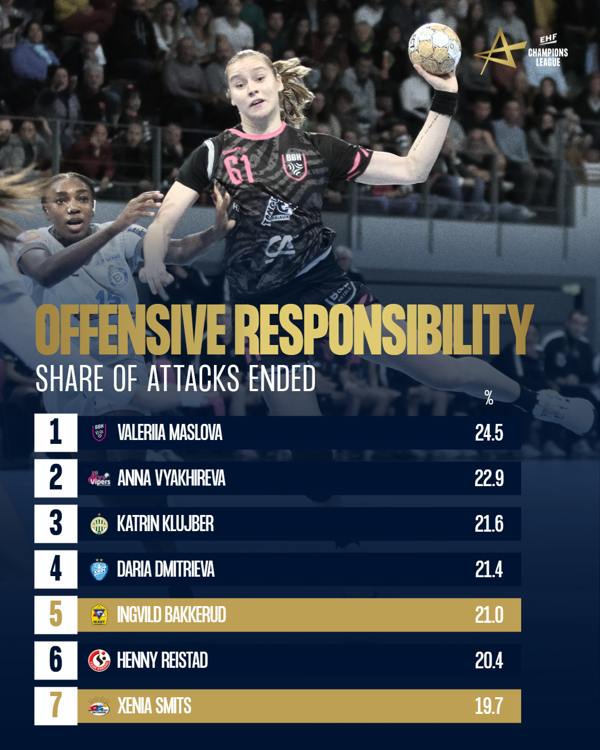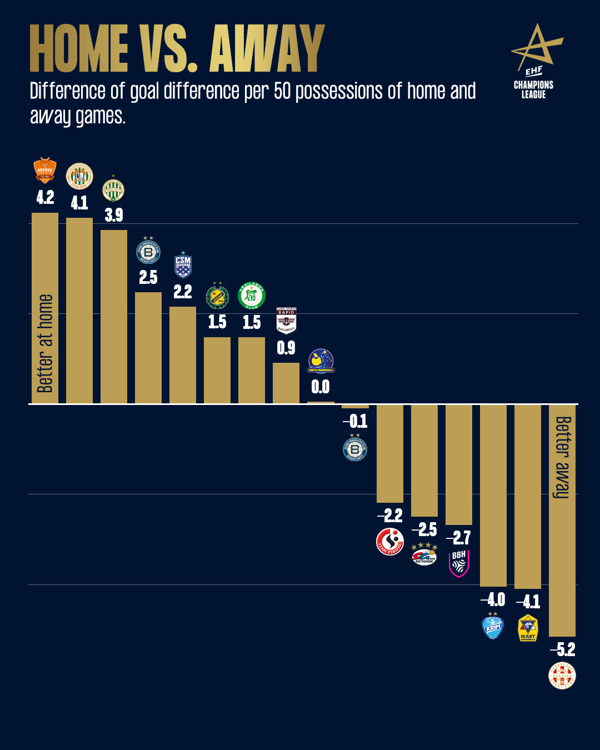As they finished third in their group, Ikast Handbold were favourites going into their EHF Champions League Women play-off game against SG BBM Bietigheim, who finished sixth in their group. However, after a 27:29 loss in the first leg, Ikast are now the only better-placed team that must overcome a deficit to progress to the quarter-finals.
Ikast’s big strength in the group stage was their offence, as they scored the most goals per 50 possessions of the EHF Champions League with 28.9. Adjusting statistics for possessions played is significantly more meaningful than just the raw number of goals (conceded) because it makes teams actually comparable since the raw number of goals is not only influenced by efficiency but also by the number of possessions (whether a team and their opponents play rather fast or slow). They were especially outstanding in handling the ball as 8.0 turnovers per 50 possessions were the fewest amongst all 16 teams.
However, in Ludwigsburg they had their second worst offensive performance of the season, scoring just 25.0 goals per 50 possessions (27 goals in 54 possessions). Meanwhile 11.1 turnovers per 50 possessions was the third most they had in one game this season. Ingvild Bakkerud (five), Emma Friis (two) and Sarah Iversen (two) all had season-highs in turnovers in one game.
In addition, Ikast’s shooting percentage of 60.0 per cent – their fourth worst of the season – was also well below their previous average of 65.7 per cent, which was only 0.2 percentage points behind the best-placed Odense Håndbold. In particular, Markéta Jeřábková struggled, even though she scored five goals. From the field as she was just able to convert two out of seven attempts (28.6 per cent), her third worst of the season, even though going into the game she was the fourth most efficient field scorer among back court players to have taken at least 100 shots, with 61.1 per cent.
Bieitgheim had more problems with Ingvild Bakkerud. The left back is the most important player for Ikast’s offence this season as she is responsible for 21 per cent of the end of their plays by shooting from the field, loosing the ball or receiving a penalty shot – ahead of Jeřábková (15 per cent). Against Bietigheim, her offensive responsibility of 28 per cent was her second highest of the season, while seven goals from 11 shots (63.6 per cent) made this her third most efficient game.

For Bietigheim, Bakkerud’s equivalent as the central figures in attack are Xenia Smits and Karolina Kudłacz-Gloc with offensive responsibilities of 19.7 per cent and 15 per cent. Last Sunday, they took even more control of the game and were responsible for 25.5 per cent and 21.8 per cent of the ends of their team’s attacks. Scoring eight shots from 12 (66.7 per cent) and five from seven (71.4 per cent) respectively, the backcourt duo was also quite efficient.
Turnovers key for Bietigheim
From the point of view of Bietigheim’s defence, which statistically was slightly above average going into the game, the numbers against Ikast were rather average as well, which they can be very satisfied with given the Danes' offensive strength. Offensively, the same applies. Jakob Vestergaard's team had slightly above-average numbers after the group stage, and they were able to confirm this against Ikast.
Interestingly, they even had the fewest turnovers per 50 possessions with 7.3, which was rather a problem for them so far as they averaged 11.8, the fourth most, in the group stage. However, Ikast defence have been very harmless here all season, forcing just 8.4 turnovers per 50 possessions in the group stage, fewer than any other team.
Bietigheim were once again able to exploit one of their great strengths in attack against Ikast. They managed to receive twice as many seven-metre penalty shots (six) as their opponents. No other team has received as many penalties as Bietigheim (5.4 per 50 possession) this season. Here too, Ikast stands at half of Bietigheim with 2.7 received penalty shots per 50 possessions, which is the fourth worst in the competition.
In just two games this season Bietigheim received fewer penalties than their opponents. Even though they score below average from the seven-metre line both this season (71.3 per cent) and against Ikast (66.7 per cent), both scores are still clearly above average for a shot from the field and thus an advantage efficiency wise.
Home court advantage?
The leverage points for Ikast to turn around the deficit in the second leg seem to be clear, especially with home court advantage on their site. However, even though they had the second most points at home of all EHF Champions League teams (11) behind just Metz and Esbjerg (12) their away statistics were much better in the group stage.
As mentioned earlier, Ikast has the best offence of the EHF Champions League. Surprisingly, they do much better away from home (29.6 goals per 50 possessions, first) than in their own arena (27.6, sixth).
In defence, the same pattern shows. At home they concede 27.3 goals per 50 possessions (12th), while away it is just 25.3 (10th). So overall, Kasper Christensen’s team scores just 0.2 goals per 50 possessions more than they concede at home, which is just ninth best. Away, they score 4.3 goals per 50 possessions, which ranks first. So, overall, their goal difference is worse by 4.1 goals per 50 possessions at home than away.

However, the away table does not reflect that as they have won one point less there. But still, after the group phase, only Györi Audi ETO KC had more points (12) in away games than Ikast (10). Nevertheless, at home, almost all of the victories of the team from Midtjylland have been narrow. Instead, they were much more convincing away, aside, of course, from last Sunday.
Bietigheim are average at home and away as well with eight points at home and six away in the group stage. Their stats are more stable than Ikast’s as all of their efficiency numbers are around average. In defence, however, they manage to step up from conceding a somewhat below average 26.4 goals per 50 possessions at home to an above average 23.6 away. Overall, their goal difference per 50 possessions is 2.5 better away than at home, which is a little less than Ikast – but the Danes have to play at home now.
All this, in addition to the fact that Ikast won just two of their seven home games with more than the required two goals difference that they need on Sunday, makes it seem that Bietigheim’s chances of the quarter-finals are not that small.
Ikast has some problems to fix in their attack, which is especially going to be a challenge given their offensive problems during the group stage. If Bietigheim are able to limit Jeřábková and use their advantages again they could become the first German team in the quarter-finals of the women’s EHF Champions League since Thüringer HC in 2014/15.
More from data analyst Julian Rux can be found at Handballytics.de. There you can read his latest articles, in which he analyses all kinds of handball topics from new, data-based perspectives. You can also find him on Instagram, Facebook, X (Twitter) and WhatsApp Channels.
Photo © Marco Wolf








